Free Share of Search Tool
A simple yet effective online tool that calculates the share of search for any brand or company in Google Search. Just enter brands, topics, or keywords and see how popular they are compared to each other!
What is share of search?
Share of Search (SoS) is a marketing metric that measures the number of branded organic searches a company receives from Google Search, relative to the total number of organic searches for all brands in the same industry within a certain time frame.
The share of search was established by marketing experts Les Binet and James Hankins in 2020 as an equation that can help businesses better understand the effectiveness of their marketing strategies and track the overall performance of their campaigns.
Share of search vs. share of voice vs. share of market
Share of Search, Share of Voice, and Share of Market are metrics used by marketers to evaluate the overall brand awareness of a company but from different perspectives:
- Share of Voice (SoV) - It measures a brand's media expenditure across various marketing channels, compared to the total media expenditure of all brands, products, or services in the market. While SoV was a reliable advertising metric for predicting a company's marketing success in the past, it has become less so with the evolution of the internet and online marketing strategies.
- Share of Search (SoS) - It measures branded keywords of a company in comparison to the competitors' branded keywords within Google Search. Unlike the SoV metric, the Share of Search can actually evaluate the outcome of the marketing activities and predict the market share of the company.
- Share of Market (SoM) - measures the amount of sales a company generates within a specific time period compared to the total number of sales in the entire industry or product category. Both SoV and SoS metrics can be used as predictors of a brand's market share (SoM).
Why is share of search important?
Share of search can help you better estimate how popular is your company in the online world as well as predict how consumers within your industry are likely to buy a product or service from you.
There are multiple reasons why you might utilize the share of search as opposed to other popular marketing metrics:
a) It's easy and reliable
Share of search allows you to easily check and track brand awareness in Google Search at any given point in time.
All you need is search volume data about your branded keyword, which you then compare with the branded organic searches of all companies in your industry:
- High share of search = the brand is more popular than its competitors.
- Low share of search = the brand is less popular than its competitors.
That's it.
The SoS data can be obtained in a matter of seconds without any difficult calculations or exhaustive surveys that would cost both time and money.
Unlike other KPI metrics (e.g. advertising budget or customer reports), the share of search also provides more accurate, real-time data about your brand that you can actually work with.
b) It tracks the impact of your marketing efforts
Share of search can help you monitor and evaluate the success of your marketing campaigns over time, and identify those that have effectively boosted the brand's visibility within the search engine the most.
Generally speaking, KPI metrics such as share of voice can only predict the outcome of your marketing activities - not measure their success.
By tracking and analyzing the share of search data, you can actually monitor how your brand is growing (or declining) in terms of branded searches, compare it with your competitors in Google SERPs, and adjust your marketing strategy accordingly (or even find areas where your marketing activities may be lagging behind that of your competitors).
c) It correlates with the market share
Share of search can be used as an indicator of a brand's market share - companies with higher branded searches tend to also have a higher number of sales compared to other brands within the same niche or industry.
According to James Hankins (and Les Binet), the share of search is a robust predictor of a brand's market share due to a strong correlation (83%) between SoS and SoM metrics:
 and Share of Market (SoM) - Chart by Les Binet-1dc7917eae5ef00ae3bd254a5956bbb46503f8d4c8628c9fb5dff8ec02891a4d.png)
Source: IPA
Therefore, regularly checking and evaluating the share of search can help you better estimate the actual market share of your company (and SoM of your competitors).
How to calculate share of search?
Share of search can be calculated as the total search volume of your branded keyword divided by the combined search volumes of all brand-related keywords in the industry. The result can be then multiplied by 100 to derive the percentage SoS value.
Formula: Share of Search = (Search vol. of the brand ÷ Combined search vol. of all brands in the industry) × 100
So, for example, if the branded keyword of company A has a search volume of 2000, and companies B, C, and D, which are within the same industry or product category, each have search volumes of 1000, the share of search for company A would be 40%.
Example: Share of Search = 2000 ÷ (2000 + 1000 + 1000 + 1000) × 100 = 40%
The precise search volumes for any brand-related keywords can be obtained with tools like KWFinder; however, manually calculating the share of search like this on a regular basis would be unnecessarily time-consuming.
A more convenient way of generating share of search data for your brand is to simply use free tools such as:
Google Trends
Google Trends is a free online tool that can provide relative Share of Search (SoS) values for brands and companies.
To get an overview of the share of search for your brand, simply enter your branded keyword along with brand-related search terms of your competitors (up to 5 brands).
You can also select a specific region or country and a certain time period.
Google Trends will then display a high-level overview of all the entered brands in the form of an “Interest over time” chart - search interest for the given branded keywords is expressed on a scale from 0 to 100 (the higher the better):
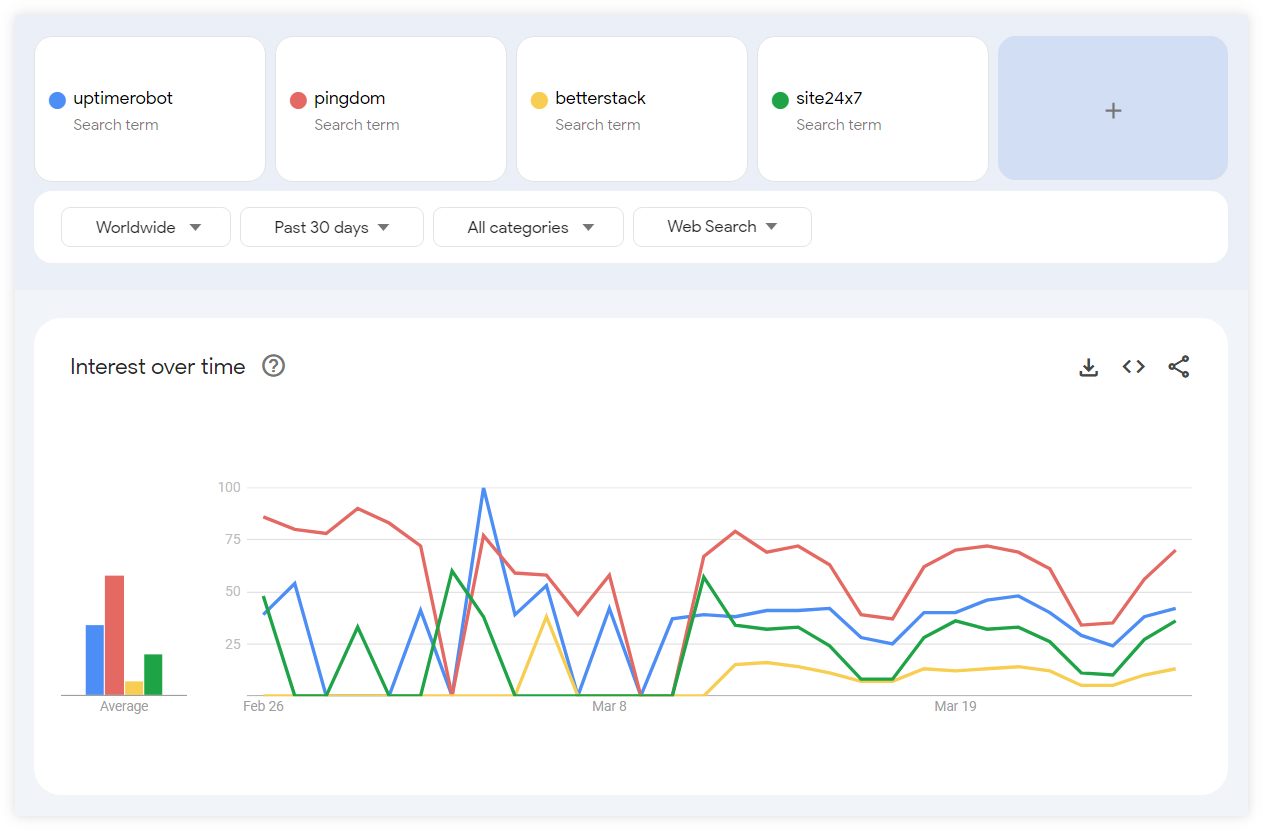
Using Google Trends for measuring SoS however, has a few drawbacks and limitations:
- Relative values - Instead of providing precise search volume data for branded keywords, the tool evaluates the inserted search terms based solely on relative search interest values (not absolute numbers).
- Misinterpreted search terms - Google Trends often fails to recognize the provided branded keywords, or misinterprets the given term as relating to a completely different brand, product, or topic.
- Company not found - The tool doesn't always identify or recognize entered companies, or their branded search terms.
Mangools Share of Search tool
Mangools Share of Search is a free online tool that provides accurate search data for any branded term or product category within Google Search.
You can enter branded keywords (or topics) for your and your competitors' companies, and evaluate the share of search of the brands in your specific industry.
In addition to the overall SoS, you can also obtain more granular data by analyzing the industry share of search in a specific region or country, as well as within a specific timeframe.

After entering your chosen keywords, you can switch between the relative and total share of search values.
This will give you a better overview of each branded search term in the "Share of search in time" chart:
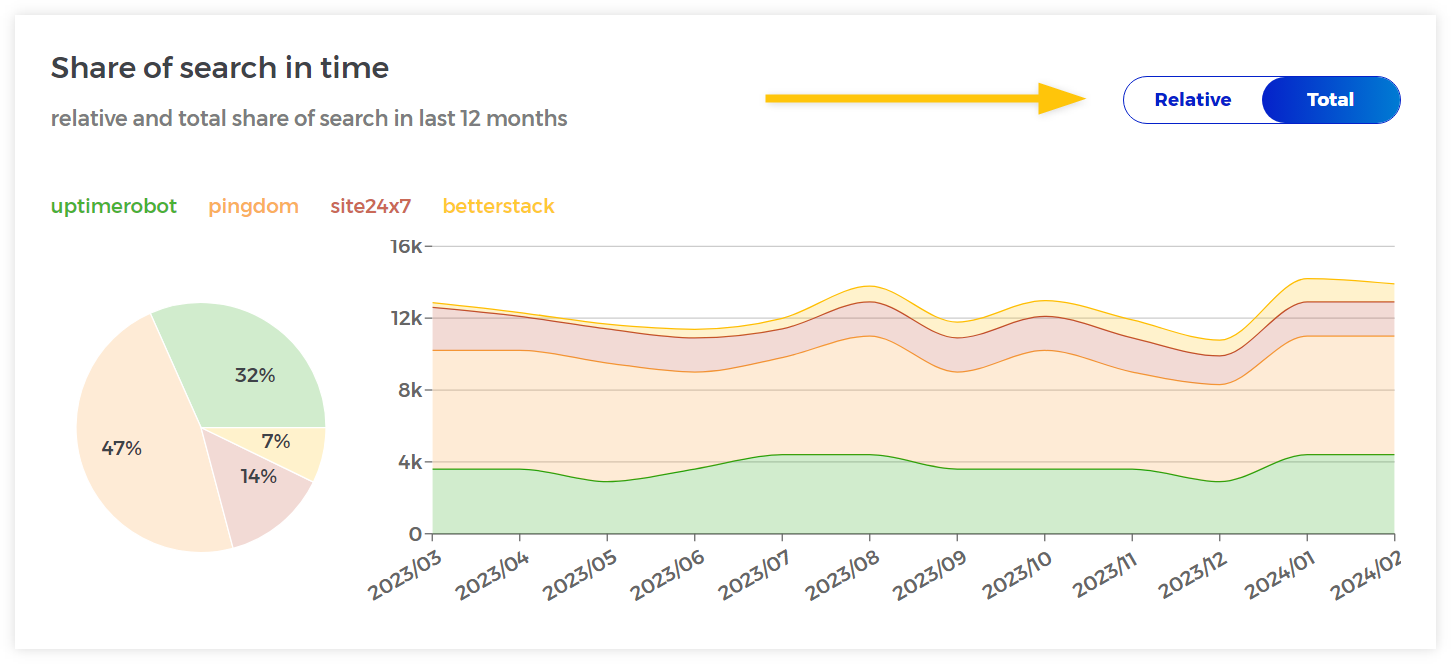
You can also check the overall search volume of all the entered brands combined in the “Total search amount” chart:
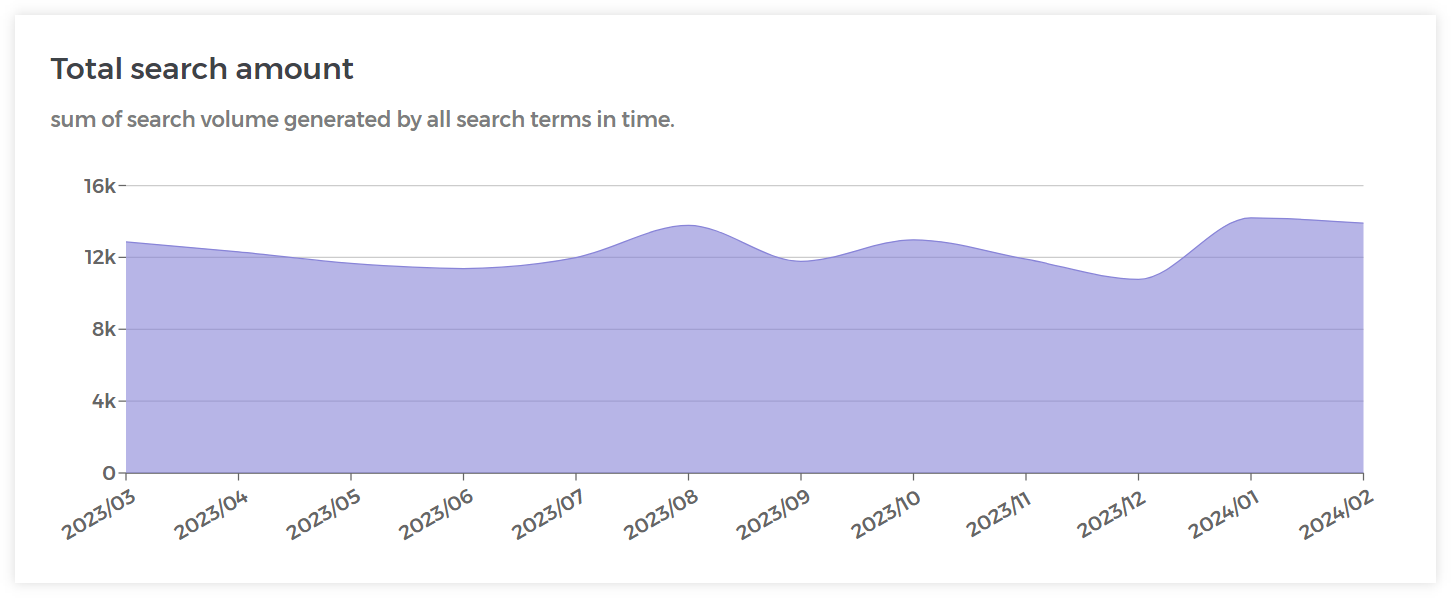
How to improve share of search?
In order to improve the share of search in your industry, you need to analyze your competitors, identify and address gaps in your marketing strategy, and optimize your share of voice expenditure to get the most from your marketing efforts.
From an SEO perspective, there are many ways to enhance the share of search for your branded search terms and boost your company's overall online presence:
- Perform competitor keyword analysis
- Focus on Surround Sound SEO
- Boost your link-building outreach
- Track and compare your SERP visibility
1. Perform competitor keyword analysis
Analyzing organic keywords that your competitors are ranking for in Google Search will help you uncover hidden opportunities that can improve the brand's website awareness and increase the overall search volumes for your branded search terms.
With KWFinder, you can simply enter the domain of any competitor in your industry to check all branded and non-branded keywords they are ranking for, along with many useful SEO metrics such as search volumes and keyword difficulty:
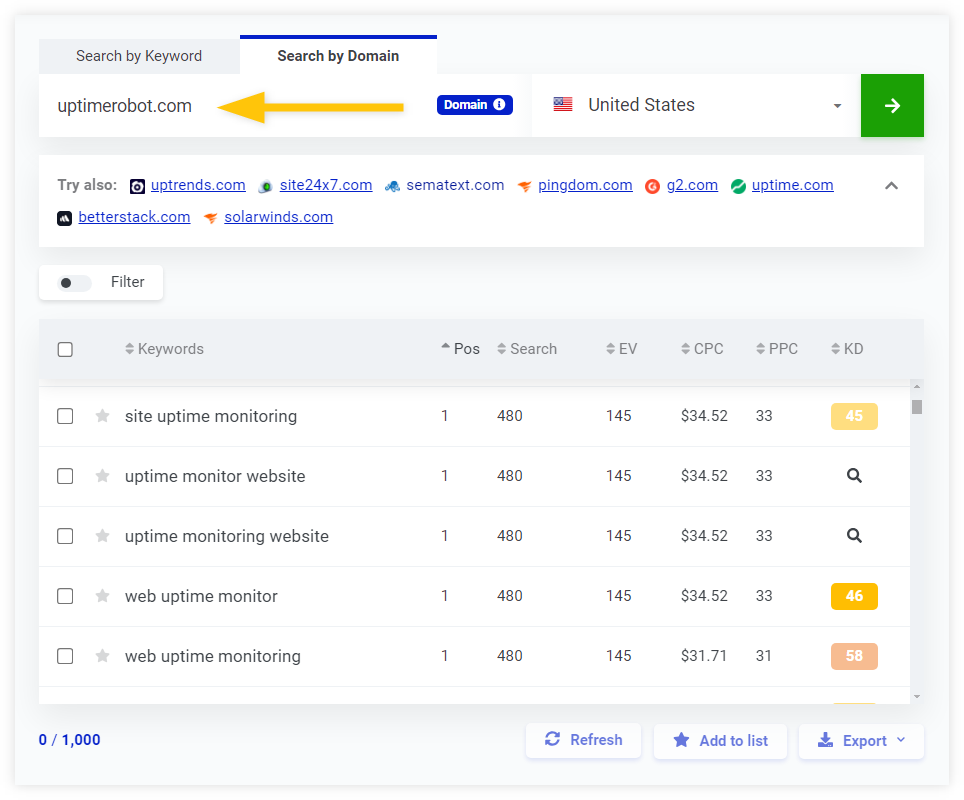
With a list of organic keywords, you can plan and optimize content on your website, potentially "capturing" some of the organic traffic from your competitors.
This strategy can help you steadily enhance your online presence in Google SERPs, boost your company's brand awareness, and consequently, increase the share of search for your brand over time.
Tip: If you are not sure who exactly your competitors are in Google Search, simply enter your website into KWFinder and check the “Competitors suggestions” tab - the tool will show you a list of possible competitors that your website is up against. 😉

2. Focus on Surround Sound SEO
Surround Sound SEO is a marketing strategy that focuses on brand mentions on external websites that rank at the top of Search Engine Results Pages (SERPs) for relevant and highly searched keywords in your niche.
The share of search for your company brand can be improved not only by ranking for organic keywords with your own website, but also by having your brand, product, or service mentioned on other top-ranking pages in Google Search.
The main goal of this SEO strategy is to enhance the SERP visibility for your brand and (ideally) improve the overall brand awareness for your company.
For instance, let's take a look at UptimeRobot (website monitoring service) and a relevant long-tail search query in its niche, such as “top uptime monitoring tools”.
If we check this keyword in our SERPChecker tool, we can see that the website is not ranking anywhere at the top. However, the brand is mentioned and recommended as one of the best monitoring tools on 2 other websites which are ranking right at the top of the SERP:
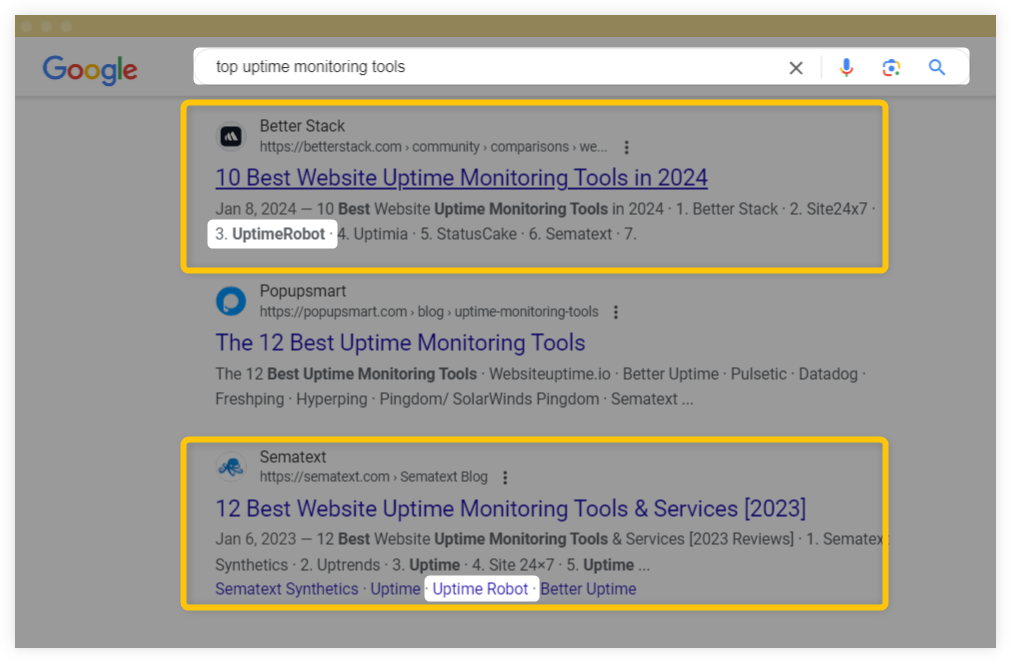
By showcasing the company and its services on high-ranking web pages like these, many new users may eventually start searching for the UptimeRobot brand in Google Search.
This could ultimately enhance the website's share of search and (potentially) lead to increased conversions.
3. Boost your link-building and PR
Link-building is a core part of SEO, but it can also directly influence your brand's share of search and overall market share.
Being mentioned and linked from relevant websites can expose your brand to a much wider audience which, in return, will boost your site's authority and improve the company's brand awareness.
When building backlinks using PR methods, it's important to understand that the focus should be on promoting your brand and highlighting its products or services.
In other words: PR first, link juice second.
With LinkMiner, you can easily analyze the backlink profile of any competitor in your industry, investigate websites linking to it, and reach out to those that can enhance your brand and share of search.
To find the most suitable websites for your PR outreach, simply enter your competitor's domain into the tool and sort its backlinks according to a variety of filters (e.g. Citation Flow, Trust Flow, referring domains, anchor texts, etc.):
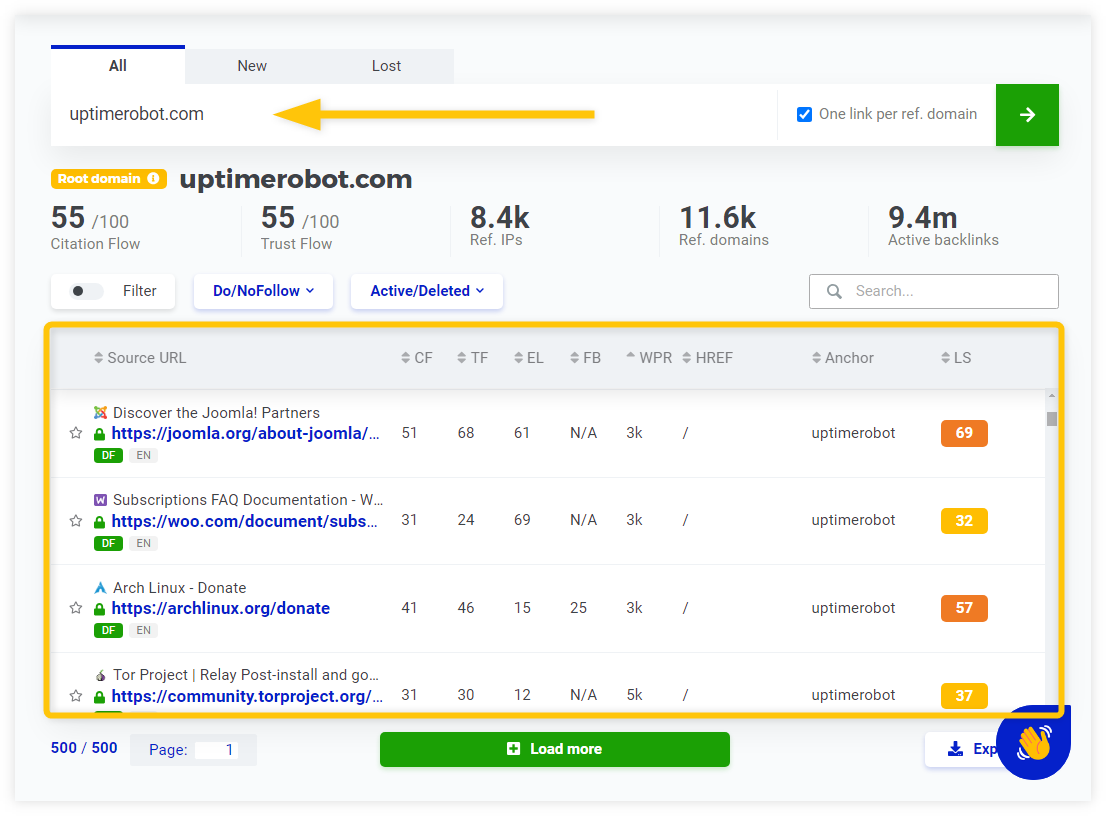
With the share of search in mind, you might consider analyzing and reaching out to external sites with a high WPR (Website Popularity Rank) - a metric that estimates the popularity of the linking domain based on the number of unique visitors, page views, etc.
This will help you not only obtain valuable backlinks SEO-wise but also place your brand in front of larger audiences - which will significantly improve your overall SoS value.
4. Track and compare your search presence
Although the share of search can be used as a reliable long-term metric for brand-related keywords, you should also monitor and assess rankings for non-branded search queries that are relevant in your niche.
Tracking and analyzing the ranking performance of your website will provide you with more precise and detailed data about your brand and its visibility in relevant Google SERPs.
With a ranking-tracking tool like SERPWatcher, you can simply input your domain (as well as domains of your competitors), add the most important keywords in your industry that you want to track, and start monitoring the performance of entered websites on a day-to-day basis:
SERPWatcher provides two essential metrics that can directly correlate with your share of search value:
- Performance Index - It measures your website's performance based on its current ranking positions and the search volumes of your tracked keywords.
- Visibility Index - It evaluates your website based on the visual dominance of its web pages and the covered area at the top of the SERPs.
You can utilize both the Performance and Visibility Index not only for tracking your website but also for monitoring brands that rank for the same keywords as you do.
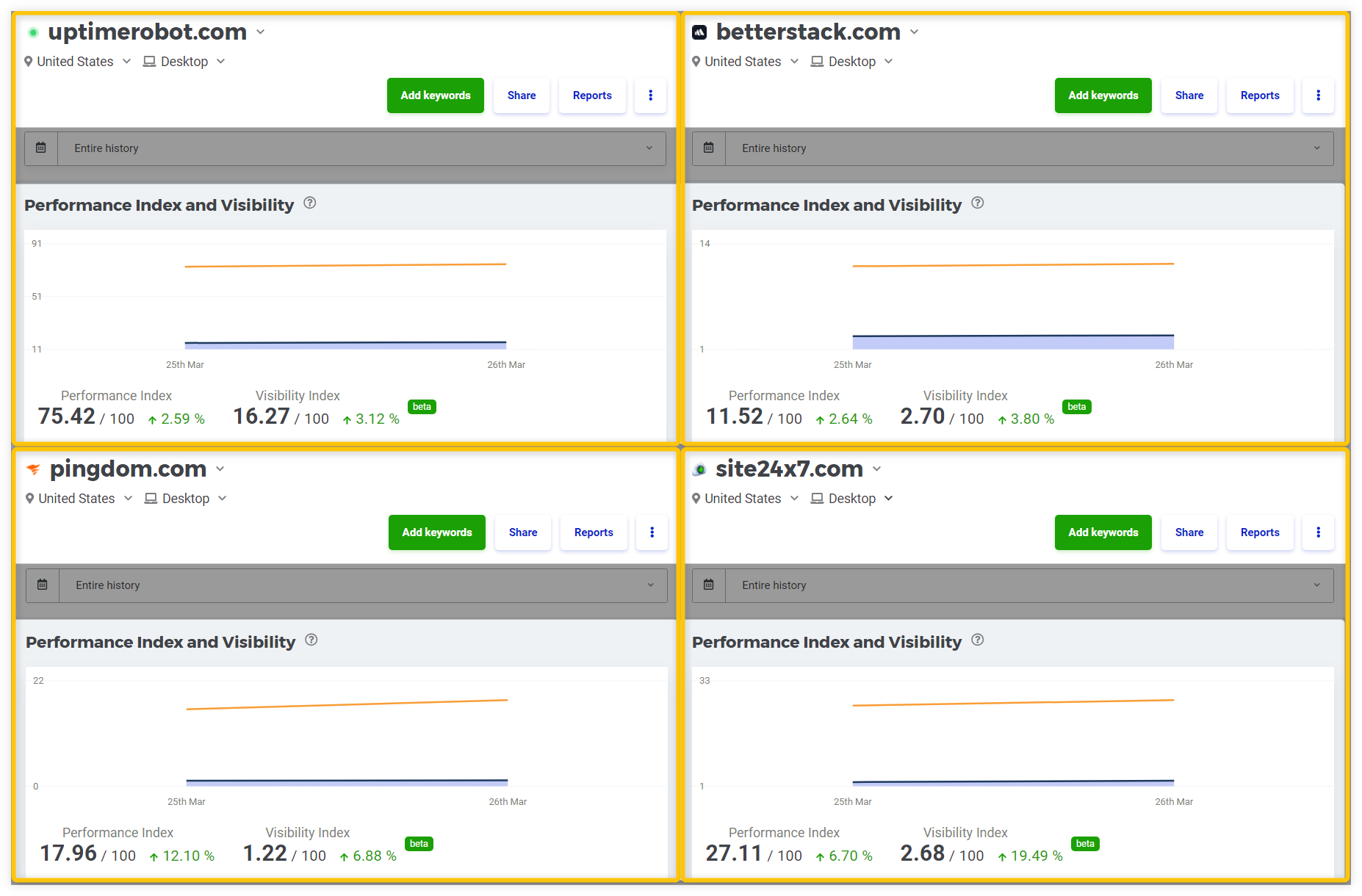
Share of search limitations
Although the share of search metric can provide a valuable overview of your brand's or product's strength in Google Search, in some instances, it may obscure the actual state of companies within the online world.
Brands that are too big
Share of search metric can be challenging to apply to multi-industry brands that produce various types of products or offer multiple services.
For example, if we try to compare the share of search among smartphone brands like Apple, Samsung, and Sony, we wouldn't be able to get accurate SoS data since these brands provide multiple product categories for smartphones, tailored for various customer types.
In addition to that, it wouldn't make sense to assess their share of search values solely as brands because all three of them also sell other types of devices, not only smartphones.
Brands that are too small
In some cases, it might be impossible to assess the share of search value for a brand that's too small or just recently established, simply because there aren't any branded searches for it yet.
In cases like this, it's better to focus more on non-branded search queries and gradually build up the brand's online presence from scratch.
Brands that are too generic
Many companies often have brand names that may be hard to spell (e.g. Schwarzkopf), have multiple nicknames (e.g. Coca-Cola vs. Coke), or are inherently too generic (e.g. Eastern).
Because of these factors, estimating the share of search for such brand names can be challenging - there could be multiple variations for branded searches, or their search volumes might be diluted due to the numerous meanings behind those keywords.
Frequently asked questions
What is SoS in digital marketing?
SoS (Share of Search) is a marketing metric that measures the brand's visibility in Google Search compared to all other brands within the same industry.
What is the relationship between SoV, SoS, and SoM?
SoV (Share of Voice) estimates the overall success of the company's marketing strategy which directly influences the SoS (Share of Search). The value of the SoS directly correlates with the SoM (Share of Market) metric. Higher SoV (marketing expenditure) leads to higher SoS (Brand's SERP visibility in Google) and therefore to higher SoM (number of generated sales by a company).
How is the share of voice calculated?
While there isn't a universally accepted formula for the Share of Voice, you can calculate the SoV as the number of brand metrics divided by the total number of industry metrics and then multiplied by 100.
What are the different types of share of voice?
Depending on the industry your brand is operating in, you can divide the Share of Voice (SoV) into various types. In general, the SoV can be divided and broken down into numerous types and subtypes, such as: SEO, PPC, social media, organic traffic, CTR, backlinks, number of shares, etc.
What is the formula for market share analysis?
Market share can be calculated as the number of sales by a specific company divided by the total number of sales in the industry over a certain time period.